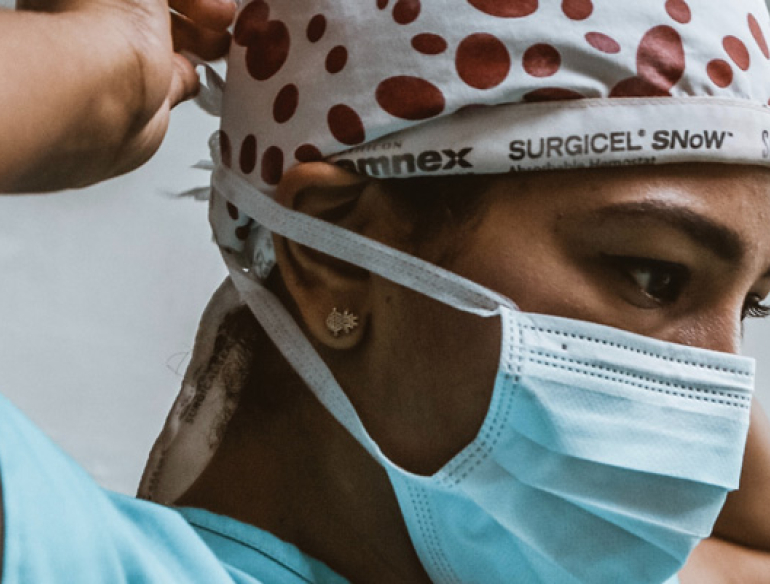A new study has estimated how health workers’ risk of SARS-CoV-2 infection differs from that of the broader community.
(SYDNEY, Thursday 12 November, 2020) Australian doctors, nurses and other healthcare workers are nearly three times more likely to get COVID-19 than other Australians, a new study of the early pandemic period from UNSW Sydney’s Kirby Institute published in the International Journal of Nursing Studies estimates.
Australia currently does not have a system for publicly reporting COVID-19 in healthcare workers, so the researchers, led by Head of Global Biosecurity at the Kirby Institute, Professor Raina MacIntyre, conducted a study to estimate Australia’s numbers using publicly available data.
“Despite low community prevalence during the period studied, which was prior to the second wave in Victoria, we identified 536 cases of COVID-19 among Australian healthcare workers up to the beginning of July, meaning that more than one in 20 of Australia’s COVID-19 cases were potentially acquired on the job, in our health system,” says Prof. MacIntyre.
The researchers say this finding should inform work health and safety procedures in Australian hospitals, and that efforts for national reporting on COVID-19 among healthcare workers should be accelerated. They also call for hospital workers to be rostered in cohorts to minimise the impact of outbreaks, better ventilation in hospitals and for improved PPE guidelines.
“Even without counting more than 3500 health workers infected in the second wave, these numbers from early in the pandemic suggest some system failures to protect our first line health responders,” says Prof. MacIntyre. “The safety of health workers should be urgently addressed.”
To conduct the analysis, the team searched government reports, websites and media reports to create a comprehensive line listing of Australian healthcare worker infections and nosocomial outbreaks – i.e. outbreaks starting in hospitals – between January 25th and July 8th, 2020. They calculated rates of infections and odds ratios for healthcare workers per state, by comparing overall cases to estimated healthcare worker cases.
“We showed that outbreaks in hospital settings have serious consequences, with a hospital in Tasmania closing in order to quarantine contacts of hospital staff. We need to remember that it’s not just those who contract COVID-19 that are impacted by these outbreaks. We showed for every health worker outbreak, hundreds, and in one case over a thousand staff, can be furloughed. There are flow on effects from a depleted workforce while hundreds to thousands of health worker contacts are quarantined,” said Ashley Quigley, first author and masters student at the Kirby Institute.
Study’s limitations highlight need for ‘proper investigation’
The data for this study were based on open-sourced reporting of health care worker cases, which may vary depending on each state’s individual data publishing policies. The researchers used media reports, which have not been verified.
“In most cases, however, there were multiple media reports about each outbreak, often with quotes from health officials. This means we have likely underestimated the true number of healthcare worker infections, so this study presents a minimum estimate,” Prof. MacIntyre says.
There is also a potential effect of testing rates on the identification of COVID-19 cases. The researchers accounted for this by representing the daily testing rates in conjunction with the daily healthcare worker infections reported.
“A large proportion of healthcare worker infections did not have source of infection reported, and we were unable to obtain further data, nor verify reported sources,” says Prof. MacIntyre.
“These limitations highlight the need for formal reporting, proper outbreak investigation and contact tracing during hospital outbreaks.”
Prof. MacIntyre says that while Australians should celebrate the country’s low daily notification counts, we’re nowhere near out of the woods. “Healthy doctors and nurses are an essential line of defence against this virus. Continuing hospital outbreaks also threaten economic recovery, as seen in Victoria when a recent community cluster was linked to a hospital outbreak, long after the second wave was over.
“Controlling health system outbreaks and protecting health workers is key to ensuring safe re-opening of society. Several countries such as Taiwan, China and Singapore have demonstrated low health worker infections. We should learn from them and the precautionary approach they have used to protecting health workers.”
Contact
Estelle Jones, Communications Officer
Phone
02 9385 9987
